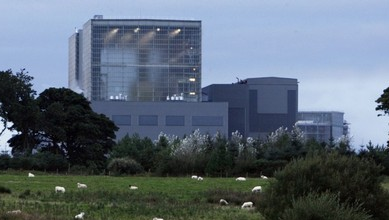Nuclear power reactors are designed for specific lifetimes, generally from thirty to forty years. Because of the huge investment required to build a reactor, when a reactor reaches the end of its designed lifespan, there is often pressure to relicense it for continued operation beyond the end of that lifespan. The big question that must be considered is whether or not it will be safe to allow it to continue to operate. As critical components wear out, it becomes more and more expensive to repair and maintain an old reactor. There is also the problem of the embrittlement of the metal in the containment vessel from the constant bombardment of neutrons from nuclear reactions in the reactor. Recently old reactors have been shut down not because they reached the end of their licensed lifespan but because they just became too expensive to continue to operate.
EDF, the French-owned utility, operates two old power reactors in Scotland. One of the reactors is located at Hunterston, North Ayrshire and the other at Torness, East Lothian. These reactors were designed and licensed to operate for thirty years. EDF requested and received permission from Office for Nuclear Regulation (ONR) to operate the two plants for an addition seven years beyond the original license of thirty years. The Hunterston plant can now operate until 2023 and Torness plant can operate until 2030.
Thousands of graphite blocks are required for the operation of these two reactors. As time passes, neutron bombardment creates cracks in the graphite blocks. Eventually, the ability of the graphite blocks to permit safe shutdown of the reactors degrades to the point where it is no longer safe to operate the reactors. The current operating licenses for the two plants allows for the proportion of cracks in the graphite blocks to be ten percent.
EDF has recently applied to the ONR for permission to raise the proportion of allowed cracks in the graphite blocks from ten percent to twenty percent. EDF says that these two reactors can continue to be operated safely beyond the seven-year extensions granted to both reactors. EDF is requesting that the Hunterston plant be licensed to operate until it is forty-seven years old in 2033 and that the Torness plant be licensed to operate until it is forty-two years old in 2035. EDF says that they will need to perform analysis on the aging plants at the end of their thirty-seven year license period to be sure that they can operate safely for the extended periods being requested.
Members of the Scottish Green Party express skepticism for the EDF plan. They are concerned that two EDF power reactors cannot be safely operated for the extended period that EDF is talking about. They say that communities located near the plants should be included in any discussion of extending the licenses for the plants beyond the current thirty-seven year periods. They do not feel that any extension should be left to just EDF and the ONR. A nuclear engineer says that the plants are currently unsafe and that both should be shut down immediately.
Hunterston B Nuclear Power Station:
